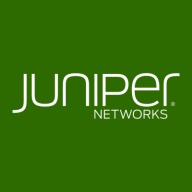

D-Link Ethernet Switches and Juniper EX Series Ethernet Switches compete in the network hardware category. Juniper seems to have the upper hand due to its advanced features and flexibility, which are crucial for enterprise-level applications.
Features: D-Link Ethernet Switches offer easy management, energy-saving green technology, and a variety of port numbers and speeds, making them versatile for various network sizes. Juniper EX Series includes advanced features like high-speed networking, extensive security options, and interoperability with other systems. The flexibility of Juniper's Junos OS and the virtual chassis enhances efficient management.
Room for Improvement: D-Link could improve stability, add more high-end models, and develop a centralized management system. Enhancements in security features and cloud integration are also suggested for D-Link. Juniper EX Series faces critiques for complex configurations and high module prices. Stability improvements and GUI interface enhancements, along with better support services, are advised for Juniper.
Ease of Deployment and Customer Service: Both D-Link and Juniper provide simple on-premises deployment. D-Link is notable for its simplicity and minimal technical support need, though support availability varies by region. Juniper, while easy to deploy, requires more customer support, which can be expensive. Users of both products often resolve issues internally, with D-Link's ease of use being advantageous.
Pricing and ROI: D-Link is recognized for its affordability with no recurring licensing fees, offering solid ROI for budget-conscious environments. Juniper has higher initial costs due to advanced features but provides satisfactory ROI for enterprise networks because of its comprehensive capabilities and scalability. Both brands emphasize a lack of ongoing licensing fees, yet Juniper's total cost can increase with support and modules.
Compared to other low-end switches with similar features, these are more robust and offer better scalability, which justifies the higher cost.
Whenever there is an issue, the local technical team supports us, whether through physical presence or remotely.
We have implemented these switches in 25 to 30 sites without significant problems.
I have not faced any hardware issues requiring support due to the stable nature of their products.
I find them very competent.
Local partners and local distributors cannot open direct tickets, but any level of partner with other OEMs such as Cisco can open a ticket directly, which is a connectivity advantage that Juniper lacks.
The pricing is competitive in the market, making D-Link Ethernet switches a good option for both middle-end and high-end brands.
There is not much scalability.
Adding another switch to an existing setup turns them into a single virtual switch.
The Virtual Chassis provides great scalability, making it a scalable solution.
The EX series supports scalability well, with newer series like EX4100 offering stacking of up to eight switches.
There are no stability issues with D-Link Ethernet switches.
The integration has been successful with no security breaches or network disturbances.
The stability of D-Link Ethernet Switches is good.
They have separate control and forwarding planes, which enhance scalability and stability.
During peak time at nine, the traffic passes through the switches perfectly.
Juniper EX Series Ethernet Switches proves to be an equally good switch.
Improvements in the voltage facility, like increasing from 360 watts to 400 or 450 watts, would make them more competitive with other vendors.
Currently, D-Link Ethernet Switches are often not used in large data centers due to issues with performance and scalability.
One area that can be improved is the handling of power interruption, as it can cause the platform to crash.
Some integration with AI could be a good idea since I heard that Juniper already has systems to deploy AI within the EX device, but I haven't had the opportunity to try that.
With other OEMs, customers or partners can directly open tech tickets.
High-end switches should be slightly cheaper.
The pricing of D-Link Ethernet Switches is cost-effective.
D-Link Ethernet Switches are 30% cheaper than Cisco switches.
The switches have become more expensive than before.
It is rated high on the scale, and I would say it is definitely on the high side, confirming a rating of one, which means it is very expensive.
In terms of pricing, the Juniper EX Series is cost-effective compared to competitors like Cisco.
It's especially valuable because Cisco and other products function similarly, but for smaller networks where high transfer rates aren't necessary.
The features of D-Link Ethernet Switches that have proven most beneficial in managing network traffic include their cost-effectiveness, which is suitable for small data centers.
With D-Link Ethernet Switches, I do not face any network load issues.
We are using the Juniper MX 104 L3 switches and SRX 1500 firewall since 2019, and we have not faced a single failure.
The important thing for our use case of Juniper EX Series Ethernet Switches has been reliability, and there are features such as the Virtual Chassis feature, which is one of the things we use.
Juniper EX series switches offer great technology, particularly their Virtual Chassis technology, which is an excellent feature for stacking switches and functions like a single virtual switch.
| Product | Market Share (%) |
|---|---|
| Juniper EX Series Ethernet Switches | 2.9% |
| D-Link Ethernet Switches | 4.9% |
| Other | 92.2% |


| Company Size | Count |
|---|---|
| Small Business | 18 |
| Midsize Enterprise | 6 |
| Large Enterprise | 6 |
| Company Size | Count |
|---|---|
| Small Business | 39 |
| Midsize Enterprise | 17 |
| Large Enterprise | 24 |
Juniper Ethernet Switches are made up of the EX Series product line. These EX Series Ethernet Switches provide branch, campus and data center networks with access, aggregation and core layer switching solutions. The end result is secure, fast and efficient application and data delivery.
Today's enterprise networks increasingly demand mobile access, optimal availability, virtualization, and unified communications. The Juniper Ethernet Switches EX Series caters for all of these requirements, ensuring business continuity, network flexibility and maximum productivity.
Juniper EX Series switches are AI-driven, operated and managed using the Mist AI cloud from Juniper. This gives EX customers simplified operations with insights, anomaly detection and automated troubleshooting, empowering IT teams to deliver the best user experience across the wired network.
We monitor all Ethernet Switches reviews to prevent fraudulent reviews and keep review quality high. We do not post reviews by company employees or direct competitors. We validate each review for authenticity via cross-reference with LinkedIn, and personal follow-up with the reviewer when necessary.